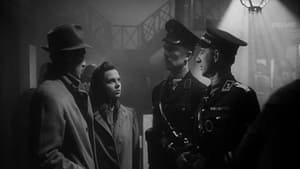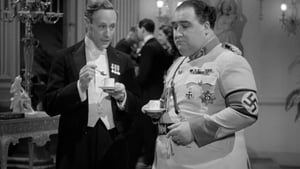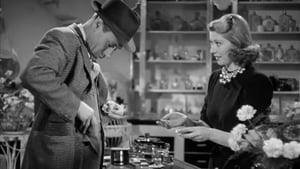Contact: info@alwanfilm.com
Video Sources 0 Views

Synopsis
Pimpernel Smith 1941 Colorized Review: An Iconic War-Time Thriller Reimagined in Color

Introduction
The 1941 British film Pimpernel Smith (also known as Mister V) is a masterclass in war-time thriller filmmaking. Directed by and starring Leslie Howard, this movie was not only a creative piece of escapist entertainment during World War II but also served as a powerful anti-Nazi statement at a time when Britain was in the thick of the war. Inspired by Baroness Orczy’s classic novel The Scarlet Pimpernel, the film transplants the heroism of its source material into the modern context of the Second World War, with a storyline set against the brutal realities of Nazi-controlled Europe. The film has recently been colorized, allowing contemporary audiences to experience this 1940s classic in a new way. In this review, we will delve into the creative vision behind Pimpernel Smith, explore its characters and story, and discuss the impact of its colorized version on the viewing experience, especially in the context of its original black-and-white aesthetic.
Check The Full Colorized Movies List
Check Our Colorized Movies Trailer Channel
Understanding Pimpernel Smith 1941 Colorized: Director, Cast, and Genre
Director’s Vision
Leslie Howard, best known for his performance as Ashley Wilkes in Gone with the Wind (1939), took on both directorial and acting duties for Pimpernel Smith. Howard’s vision for the film was clear: he sought to blend the suspense of a war thriller with the defiant, patriotic tone needed to inspire British morale during the war. In creating a modern-day version of The Scarlet Pimpernel, Howard presented a protagonist who fought not with weapons, but with intelligence and cunning. He aimed to remind audiences that heroism came in many forms, particularly in the face of tyranny.
Howard’s directorial style is marked by restraint, elegance, and subtlety. Rather than relying on bombastic action scenes, the film builds tension through dialogue, shadowy visuals, and the ever-present menace of the Gestapo. The narrative has a sense of urgency, reflecting the real-world stakes of the war unfolding as the movie was made. Howard, being Jewish and outspoken against the Nazi regime, poured a personal passion into the film, making Pimpernel Smith as much a piece of propaganda as it was a work of art.
The Iconic Performance of Actors
Leslie Howard’s portrayal of Horatio Smith, an eccentric archaeology professor who secretly smuggles prisoners out of Nazi concentration camps, is both understated and powerful. Howard plays Smith as a mild-mannered intellectual who carefully balances his dual life of academic and daring resistance leader. The charm of his character lies in his ability to outwit the Nazis with his wit, much like his 18th-century counterpart in The Scarlet Pimpernel.
Howard’s performance is complemented by an outstanding supporting cast. Francis L. Sullivan plays General von Graum, the Nazi antagonist who relentlessly hunts for Professor Smith. Sullivan’s portrayal of von Graum is cold, calculating, and increasingly frustrated as Smith continues to slip through his fingers. Mary Morris plays Ludmilla Koslowski, the film’s female lead, a mysterious figure whose loyalties are questioned throughout the narrative. Morris gives her character a layered complexity, adding a touch of vulnerability amidst the high-stakes espionage.
Exploring the Genre
Pimpernel Smith (1941) is a hybrid of genres. At its core, it is a wartime espionage thriller, but it also has strong elements of drama, romance, and the heroic adventure genre that its source material epitomized. The film plays out like a high-stakes game of chess, where intellect triumphs over brute force. The pacing is deliberate, reflecting the psychological nature of Smith’s warfare against the Nazis. The film falls within the war genre, but it also has its roots in the adventure genre, presenting a new kind of hero for a new kind of war.
Exploring the World of Pimpernel Smith 1941 Colorized: Plot and Characters
Detailed Synopsis
Pimpernel Smith opens in the heart of pre-war Nazi Germany, where Professor Horatio Smith (Leslie Howard) leads a group of British archaeology students on a research expedition. However, this is only a cover for his true mission: rescuing intellectuals and political prisoners from Nazi concentration camps. Posing as a somewhat bumbling professor, Smith secretly orchestrates daring escapes, using his cunning and knowledge of European history to outwit the Gestapo.
The film’s central antagonist is General von Graum (Francis L. Sullivan), a high-ranking Nazi officer tasked with hunting down Smith. Von Graum suspects Smith’s activities but is repeatedly thwarted by the professor’s quick thinking and clever ruses. As Smith becomes bolder in his efforts to rescue prisoners, the net around him tightens. Tensions rise when Smith meets Ludmilla Koslowski (Mary Morris), a woman with divided loyalties, and he must decide whom to trust as his mission becomes increasingly dangerous.
Throughout the film, the stakes grow higher as Smith’s double life threatens to unravel. In the climax, Smith must lead one final, dangerous escape mission that will either solidify his place as a hero or expose him to the Nazis he has worked so hard to evade.
Complex Protagonists and Supporting Characters
Professor Horatio Smith is a character of dualities: at once quiet and unassuming, yet brilliant and brave. He is the classic reluctant hero, motivated not by a desire for glory but by a moral obligation to fight against oppression. Smith’s intellectualism is his greatest weapon, allowing him to defeat the Nazis with strategies and schemes rather than physical force.
General von Graum, in contrast, represents the brutality and efficiency of the Nazi regime. His character is methodical, using reason and logic to hunt his prey, but his increasing frustration as Smith continually outwits him makes him a dynamic antagonist. Their relationship is a fascinating cat-and-mouse game, where Smith’s cleverness stands as the only obstacle to von Graum’s quest for domination.
The Art of Film Colorization
Understanding the Process
Colorization in film involves taking a black-and-white movie and adding colors to each frame, either manually or using digital techniques. This process, particularly for older films like Pimpernel Smith, requires significant attention to historical detail to ensure accuracy and maintain the integrity of the original aesthetic. For a war-time film like Pimpernel Smith, the decision to colorize comes with added challenges, as it must balance the original tone of the film with the emotional weight carried by its historical context.
Development Over Time
The history of film colorization goes back to early cinema, where colors were sometimes added by hand-painting frames. However, it wasn’t until the advent of digital technologies that more realistic and seamless colorization became possible. In the case of Pimpernel Smith, the colorization process was carefully applied to ensure that it enhanced the viewing experience without undermining the film’s original emotional gravitas.
Early Colored Films: A Brief History
Emergence of Early Colored Techniques
Early color in cinema began with processes like tinting, toning, and hand-painting frames in silent films. By the 1930s, the development of the three-strip Technicolor process revolutionized the industry, providing vibrant and consistent color in films like The Wizard of Oz (1939) and Gone with the Wind. However, many wartime films, like Pimpernel Smith, were originally shot in black and white due to budget constraints, technological limitations, and the stark, serious tones that black and white conveyed.
Pimpernel Smith and Its Early Colored Version
The Decision to Release in Color
The decision to release a colorized version of Pimpernel Smith was driven by a desire to make the film more accessible to modern audiences, who may be more accustomed to color films. The muted tones of the Nazi uniforms, the soft lighting of the European landscapes, and the sharp contrasts of light and dark that defined the original cinematography are reinterpreted in color, providing a different sensory experience for viewers today.
Impact on the Visual Narrative
The colorization of Pimpernel Smith adds a layer of richness to the visual narrative. The film’s suspenseful tone is heightened by the atmospheric colors used to represent the oppressive atmosphere of Nazi Germany. However, some purists argue that the original black-and-white format of the film better suited its themes of espionage and deception. The stark contrasts of light and shadow that define noir films, especially those set in wartime, can be diminished by color, which softens the edges and introduces a sense of realism that wasn’t part of the original aesthetic.
The Debate Over Film Colorization
Controversy Surrounding Colorization
Colorization remains a contentious issue in the world of classic cinema. On one side, filmmakers and historians argue that the original black-and-white format is an essential part of a film’s artistic vision, particularly in films like Pimpernel Smith, where the absence of color can add to the tension and atmosphere. Others, however, believe that colorization can bring new life to old films, making them more accessible to contemporary audiences who may not appreciate the starkness of black-and-white cinematography.
Examining Pimpernel Smith as an Early Colored Film
Enhancement or Distraction?
In the case of Pimpernel Smith, the colorization serves to enhance the film’s visual appeal but may detract from its original war-time gravitas. While the added color brings a modern vibrancy to the film’s visuals, some argue that the black-and-white version better captured the bleakness of Nazi-occupied Europe. For some viewers, the colorized version may soften the film’s hard edges, whereas others will appreciate the aesthetic beauty and accessibility the new version provides.
Influence and Legacy: Pimpernel Smith 1941 Colorized’s Impact on Cinema
Sparking Future War Thrillers
Pimpernel Smith had a lasting impact on British and international cinema, particularly in the wartime thriller genre. Its blend of intellectual espionage, patriotic fervor, and dramatic tension helped to inspire later films about resistance movements during World War II. Films like The Great Escape (1963) and Schindler’s List (1993) can trace their roots back to the formula that Pimpernel Smith perfected, where a single, unlikely hero fights against overwhelming odds to save innocent lives.
Director’s Cinematic Legacy: Beyond Pimpernel Smith 1941 Colorized
Leslie Howard’s tragic death during the war, when his plane was shot down by the Luftwaffe in 1943, cut short the career of a man who was not only a brilliant actor but also a courageous artist. Pimpernel Smith stands as a testament to Howard’s contributions to cinema and his dedication to fighting fascism, both on and off the screen.
Themes Explored in Pimpernel Smith
The film explores themes of heroism, sacrifice, and the moral duty to resist evil. Horatio Smith is a man of intellect, but his courage in the face of overwhelming odds speaks to the film’s message that resistance is not just about physical strength but about standing up for what is right.
Reception and Controversy Surrounding Pimpernel Smith 1941 Colorized
Pimpernel Smith was well-received upon its release in 1941, particularly by British audiences who found comfort in its patriotic themes. The colorized version, however, has sparked debate among classic film aficionados, with some praising it for its modern appeal and others arguing that it dilutes the film’s original impact.
Where to Watch Pimpernel Smith 1941 Colorized Online
Pimpernel Smith is available for streaming on platforms like Amazon Prime, and the colorized version can be found on DVD and Blu-ray formats. Viewers now have the option to experience the film in both its original and colorized versions.
FAQs About Pimpernel Smith 1941 Colorized
Q: Who directed Pimpernel Smith?
A: Leslie Howard, who also starred as the film’s protagonist, directed Pimpernel Smith.
Q: What is the significance of the colorized version?
A: The colorized version offers a new way to experience Pimpernel Smith, appealing to modern audiences while igniting debate about the artistic integrity of the original film.
Q: What are the main themes of the film?
A: The film explores themes of resistance, sacrifice, and the moral duty to stand against oppression.
Conclusion
Pimpernel Smith (1941) remains an essential war-time thriller, both for its bold anti-Nazi stance and its portrayal of intellectual heroism in a time of war. Leslie Howard’s performance and direction elevate the film, ensuring its place in cinematic history. The colorized version of the film presents a fresh way for new generations to experience this classic, though the debate over the merits of colorization continues. In any version, Pimpernel Smith stands as a powerful reminder of the importance of resistance in the face of tyranny, a message that remains relevant to this day.












